The proposition of men, designing men’s stuff is an interesting one — from Filson to designer Axes, from canvas luggage to gear that guys want. What’s the pitch?
To the general philosophy that there’s a men’s designer consciousness — to the concept that there isn’t: good design is good design. Or great, rather. What drives design, for guys?
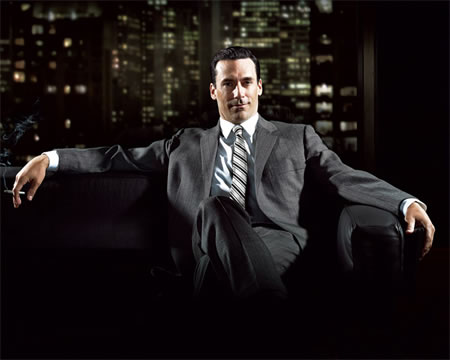
Image: AMC
There’s an intriguing postulate in the idea of “genetically inspired” design for men being something that is distinctly different, down to the DNA of the principle of how it is originated. I’d disagree. Men might like designing for men, because they know ’em. And women — for women — so too. But considering the strategies of Giorgio Armani, Karl Lagerfeld or Tom Ford — men can design either way. Do women design for men?
The descriptive arc of the curve of design strategy is just as beautiful — from women or men. Audience is the point of interception — in the note of receipt — who’s listening to the story, and frankly, who cares about it? Beautiful design is only beautiful in the sight of the holder — it doesn’t exist without embrace and relationship.
But extraordinary design, envisioned by men or women, is still extra-ordinary. The tipping point to design relevance (and resonance) is when it’s skewing to an audience — that is: it’s designed for someone in particular, not for anyone, but for someone. There’s another positioning to that strategy, that the person that is being reached to — the gesture in connection — is being allured in the telling of a story that is inherently embraceable.
People buy into brands on the notions of principles. Or price. Or both. They empathically think: “I can relate to that philosophy, I’d buy that.” That can reach to the storytelling of economics — spendthrift, please — “I’m here at Walmart because I believe in Sam Walton’s skinflint ethos, and the savings that will come to me“; to the luxuriation of something so well crafted that it’s worth waiting — and spending dearly — for. That could be, on the entry point, Apple’s iPhone|4 — scramble for a place in the digital line; or that could be a numbered, hand-made, two-year-wait fabrication period for a customized bag from Hérmes. I’d suggest that it might be a combination of the right brand-story, some sense of ongoing fascination and commitment on the part of the creative leadership, and a willingness to stick it out, through thick and thin, to stay alive (and to keep the visionary spark igniting.)
It’s the balance between the story that matters to the heart and ultimately, the story that means something for the audience — consumer, guest or otherwise.
Working as a consultant at P&G, earlier in my career, I’d partnered with a leadership team in building out the concept of the accelerated branding platform we call BrandQuest®. It caught on at Procter like wildfire — and rather than afternoon or day innovation / brand-storming sessions, these quests were days long — three days at a shot, with the culminating outcomes of three wholly realized branding and product propositions. Three new brands: new names, new positioning, new product offerings, new strategies, new identities, packaging and visualizations. All new, all fast – and from there, straight to the CEO of P&G, A.G. Lafley and Susan Arnold for review.
To examine any brand potential, there’s an issue of who’s going to relate to it. Relate, etymologically considered, is partially linked to reference and to a kind of “carrying back” – the oblate bridging of an idea to a new comprehension, a way of explaining. Most brands need a story to be explained — could be simple, could be complex, but the narrative bridge between story, narrative connection and meaningful memory is well documented. Girvin’s been writing about it for years.
Working at Procter — building these foundations — we looked for archetypal positioning that supported trend; and back then, part of that trend was working on men’s products — things that link back in a manner to satisfy a male self perception of relatedness. And, at the beginning of the brand, we met Jack Spade. I like these boots because… I like this coat because…
“I like this bag designed by Andy (Jack) Spade because….“
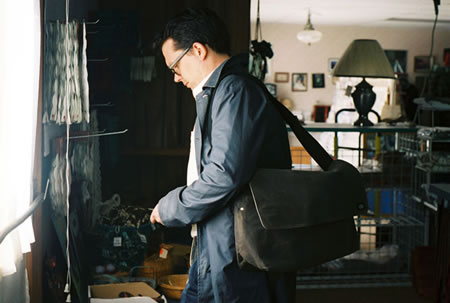
Interestingly enough, when we first found Andy, back in the 90s, there seemed to be only him, and another employee. Or two. Not big, very tiny little shop just around the corner from another brand that he’d invented with his wife, Kate Spade. Yes, well, we knew Kate Spade, but we liked the idea of someone — the other Spade — making stuff just for guys.
This kind of stuff.
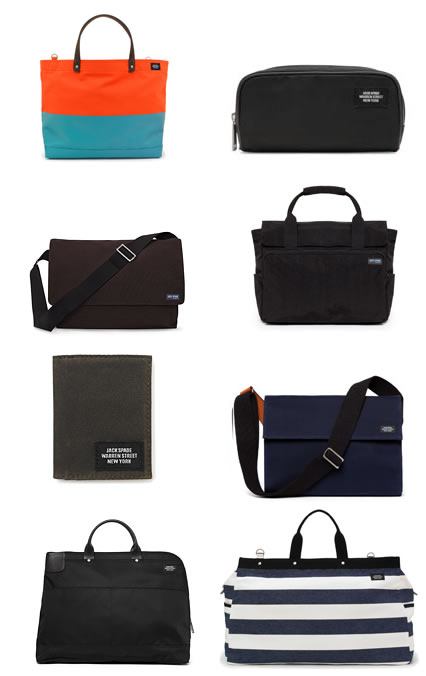
Simple, clear intentions, masculine details: hard-working.
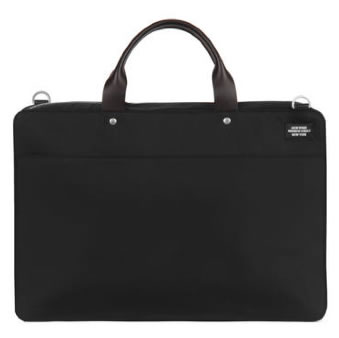
Of course we didn’t know that actually Andy and Kate worked together to build the Kate brand, as well as the Jack.
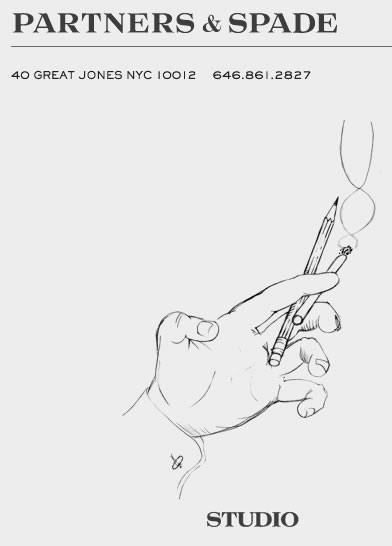
But they’ve got this studio, a simple design partnership, for doing just this kind of collaboration. Small, but interesting. Andy’s surely a design theorist — but he’s authentically making the product, as well as the man’s brand, too. Video, here.
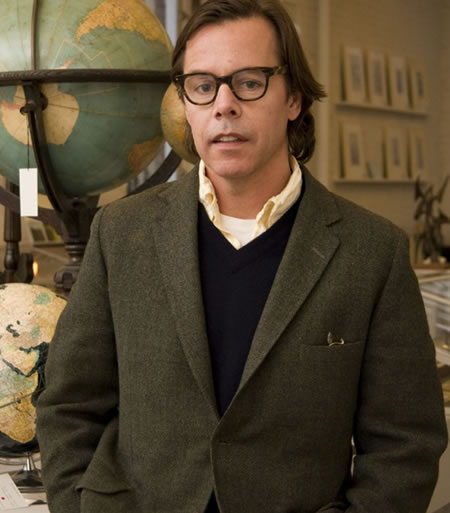
Mr. Spade
The fabulous blogger, ACL — A Continuous Lean — has a conversation with Andy Spade, that outlines some of the origination of Mr. Spade’s thinking.

ACL — we’ve linked to David Coggin’s thinking in the past — in the interview below, pulled from the site, he reaches Spade at Bemelman’s, the Carlyle Hotel.
What comes of this is utility, building design that has a sense of aspiration / inspiration — there’s a story, to finding the right people to make the right thing for the right “kind of man.”

Spade clothes
“Andy Spade’s arc of success is well-documented and yet it remains a cause for satisfaction. The simple, utilitarian design exemplified by Jack Spade seems straightforward, but like a good bistro or garage band, the key is the execution. It turns out that’s not so easy after all. Jack Spade also worked because it was at home in any neighborhood, dressed up or down.” But it’s also about the utility of need, the idea that a “guy’s principle” drives the application development, that it’s not about seeing a hole in the market, per se, it’s the interpretation of experience. Andy says, “I liked Patagonia and some outerwear companies. But when I went to the office I didn’t want to carry an alpine bag, and I wasn’t attracted to designer bags. So I wanted to create something in between, with menswear fabrics. I grew up in Arizona, as a kid I hiked up mountains, and was a boy scout, and went to the Grand Canyon and camped out at night. So I knew all the sleeping bag companies.
DC: Really—mountain climbing?
AS: Well not Kilimanjaro, but that’s what you did as a kid. Those companies made things that were built for a reason. Couldn’t we make something that was really simple—but with a worsted wool—and structure it in a way that would make it last?
Our first bag was sold in a hardware store because I wanted to see how it would be received by carpenters and tradesmen. I know all the tent makers and sleeping bag companies. The Klein tool bags were the best bags but they didn’t have any internal pockets. So that was like the holy grail.
DC: So much classic design came from the military because it had to have a functional element to it.
AS: That’s true. We’re trying to think about how you live and what you need. One bag I’m proud of is the dipped bag in rubber which is just what they put on their gloves. We thought why not apply the same science—or same stupidity—to a bag?
DC: Were you surprised how Jack Spade was received—not just a utilitarian sense, but as a brand?
AS: I didn’t know if it would work or not. I was putting out something that I wanted to have. We were fortunate that Kate was doing well. Not everything worked, but we had enough time and patience to tinker and get it right. Usually you’re designing for yourself or people you know. We didn’t want to make a $1500 bag, leave that to Italians who have that mastered and have 100 years of craftsmanship behind them. It took longer than I thought to get accepted—but ultimately it started to speed up.
DC: Kate Spade became successful so quickly—the two brands seemed to be conceived differently.
AS: I like buying product from companies that specialize in making a few things well. Kate was known for making women’s bags. A lot of people said ‘Why don’t you make Kate Spade for men?’ There’s already an awareness there. Short term it may have taken off faster but long term it would have been a mistake. It needed its own identity. Jack was conceived as a functional bag for men. Kate was conceived as a bag specifically for women.
Male brand strategies — Spade brand lessons:
The bigger you get, the smaller you should act.
Never, ever start thinking like a big company. Otherwise you become corporate, and there’s no interest in that.
Never believe anything you’ve done is successful.
Challenge it every second, every day.
Brand consistency is overrated.
The brand doesn’t have to look the same, but it has to feel the same. An element of newness and surprise is important for any brand.
Brands should have some mystery.
Customers should never understand the whole picture of a brand.
Your people are your product.
They are the vehicle through which everything happens, and they define what you put out.
That idea, the implicit branding strategy of designing for men, might be something that could be rendered from a sense of history — men, designing for the market.
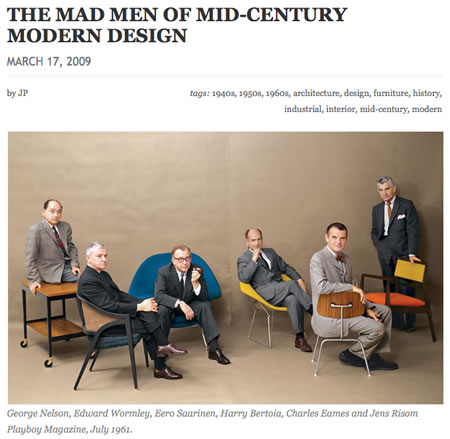
Like this rendering of design masters (Playboy Magazine — from the Selvedge Yard [for men].)

Other sites emerge, for men — brands and products, designing for them.
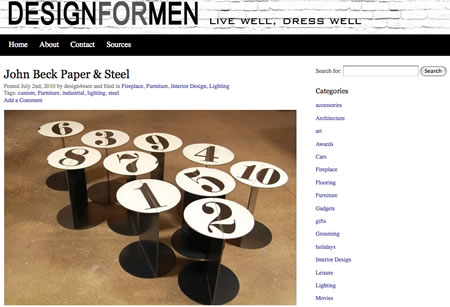
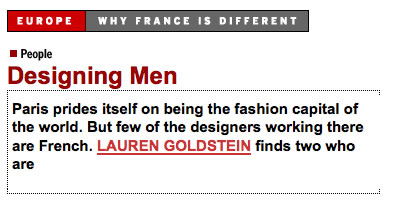
Nicolas Ghesquière and Hedi Slimane, Paris.
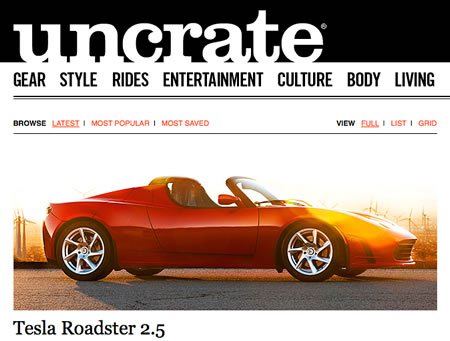
Or that might be pitches for men — as targets of design. Kind of emotionless marketing, but the positioning is there.
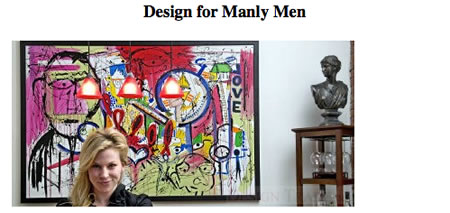
“The Hartford Courant reports that August Black, an interior design firm specializing in design for men, has enjoyed overwhelming success by taking advantage of this niche market. Taylor Spellman, founder of August Black, believes that men also want great design, but sometimes feel intimidated and alienated by the standard interior design firm. “I don’t lecture them, no matter how sloppy they are or what the place looks like, because they are the ones paying me,” says Spellman. This kind of attitude has endeared her to the bachelor-pad type gentleman who wants better style but does not know how to achieve it himself. “Men are very black and white when it comes to decorating. They want to see two, maybe three choices; they make their decision fast, and they want you in and out as soon as possible,” Spellman says.”
Or it might be, like many outdoorsman brands — clothing, equipment, tools — that are designed and made with archetypal maleness in mind.
Archetypal masculinity: manly products — the axe.
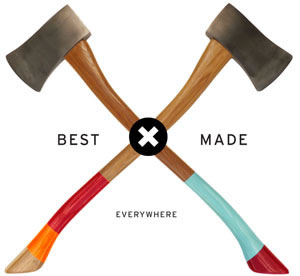
Notes from the site:
Every high-rise condo, luxury office, executive suite, ranch house, and farmstead must have a Best Made axe in it. Axes shouldn’t only be in the hands of lumberjacks: anyone who respects the merits of an axe should have one in their name. An axe is indispensable and sublime, the epitome of fortitude and strength, a perfect design object, a timeless instrument.
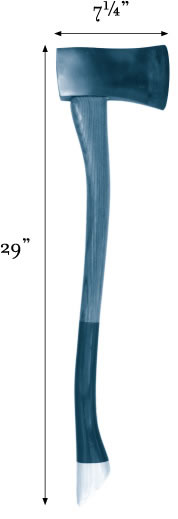
The Axe is where it all begins, it is a perch from which a new and exciting world is being born, and in this sense Best Made Co. is more than just axes. We are in the business of putting our axes and our message into the hands of people that also want something more, people that want to join us on the adventure.
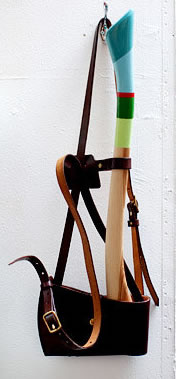
Ira Lippke for The New York Times
All our axes are made to order, designed, painted and polished individually in a small workshop environment in downtown New York City.
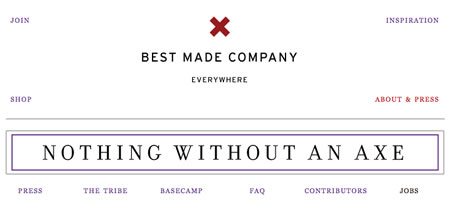
There is a story, manly:
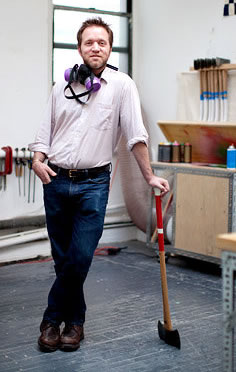
Ira Lippke for The New York Times
PETER & GRAEME
Best Made Co. was founded by designer and author Peter Buchanan-Smith, and outdoorsman and environmental entrepreneur Graeme Cameron. The two first met in 1984 at Camp Ahmek, a legendary boys camp in Algonquin Park in Northern Ontario; and it was there they learned—with love and respect—to wield an axe. As men they have both gone on to forge their own way in the world: building hand-hewn log cabins on the shores of Stoney Lake, tree planting in Kapuskasing, winning Grammy awards, getting married, having children, military life, book publishing, Scotland, rugby, whiskey, slingshots and hardwood fires that can melt glass.
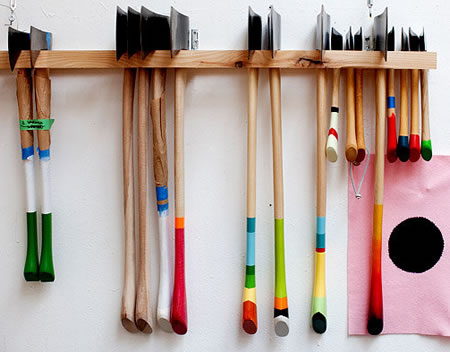
Ira Lippke for The New York Times
And brand storytelling, the product itself, “Color, pattern, and play are the guiding factors in everything we make. Even though it’s “just an axe” it’s a blank canvas with endless possibilities. When the axe is finished we sit down and think of names. The naming process is crucial: it’s where we give the axe the beginning of its story, albeit a very short story (we purposefully do not caption the axes, just give them names) because we know our customers are inventive enough to create the real ongoing story.”
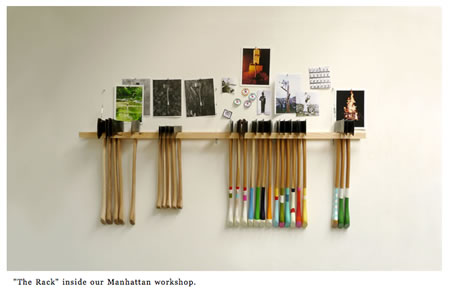
Any brand worth its salt has a story to tell. And while it might be said that, in an audience, women are more likely to relate to, and embrace, the notion of brand storytelling, men too can connect, man to man, the narrative of what men can share. In the exposure of marketing to community, the nature of building brands for men, it is something that takes a special focus — stories that are right, products that are tuned, and enterprises that are lead to speak in a certain way.
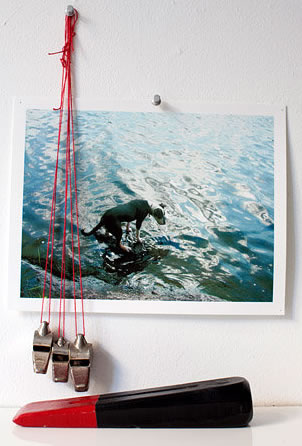
Ira Lippke for The New York Times
Men brands:
• Stories: postulating masculine ideals
• Materials: male form design language
• Layering: one positioning, that layers to others
• Consistency: the details work out, holistically
• Resilience: keep evolving, improving expressions
• Market watch: studying trend
• Simple: direct, authentic, fast
As a man, that’s what I’ve got.
T I M
–––––
H U M A N B R A N D | S t r a t e g i e s
https://www.girvin.com/subsites/humanbrands/
the reels: http://www.youtube.com/user/GIRVIN888
girvin blogs:
http://blog.girvin.com/
https://tim.girvin.com/index.php
girvin profiles and communities:
TED: http://www.ted.com/index.php/profiles/view/id/825
Behance: http://www.behance.net/GIRVIN-Branding
Flickr: http://www.flickr.com/photos/tgirvin/
Google: http://www.google.com/profiles/timgirvin
LinkedIn: http://www.linkedin.com/in/timgirvin
Facebook: http://www.facebook.com/people/Tim-Girvin/644114347
Facebook Page: http://www.facebook.com/pages/Seattle-WA/GIRVIN/91069489624
Twitter: http://twitter.com/tgirvin